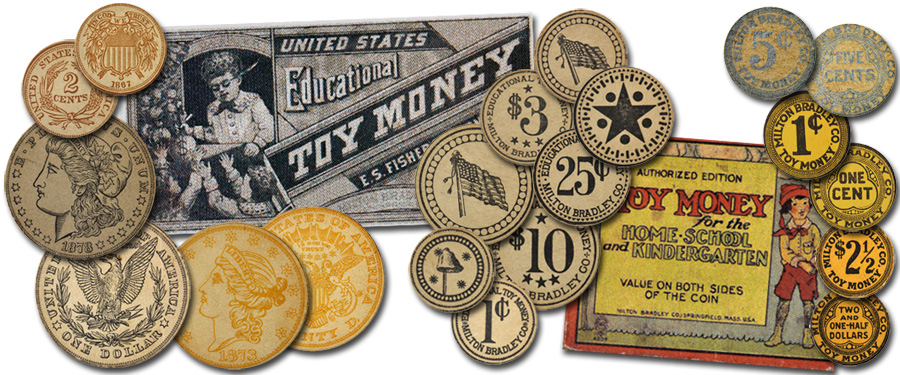
A fascinating and under-studied group of exonumia is that of play money, coins and currency made to be used by children in play or in an educational setting. These items are distinct from game money used in the context of a board game, or gaming counters used by adults in card games or gambling, but are often grouped in incorrectly with this group. In the United States, the Milton Bradley Company of Springfield, Massachusetts was the pioneer of play money, largely as part of their founder’s involvement in the kindergarten movement.
Though primarily known for his involvement with board games, Milton Bradley became involved with early childhood education starting in 1869 after attending a lecture by Elizabeth Peabody, the educator who opened the first English language kindergarten in the United States. From this point on, Bradley utilized his company to manufacture a wide array of items to be used in a kindergarten classroom. Many of these items he freely gave away.
The first iteration of play money made by Bradley bears dates ranging from 1853-1879 and is printed on white cardboard with a near-exact representation of the coins of the era. Denominations include: cent, two-cent piece, nickel, dime, quarter, half dollar, silver dollar, quarter eagle, three dollar gold piece, half eagle, eagle and double eagle. These “coins” are not marked as play money in any way. The ink used to print the coins varies, with some sets produced with black ink only, while others have copper ink for the copper coins, and gold ink for the gold. The box in which the author’s coins reside bears a patent date of March 20, 1877, however this same box cover and patent date were used for later styles as well. The underside of the lid of this set reads in part:
“This is an exact Fac-simile, on cardboard, of the common current coins in use, making not only an exceedingly amusing but at the same time a very instructive toy, the playing with which must of necessity impress upon the youthful mind the value of the different coins and the art of making change with ease and accuracy, thereby laying the foundation for Elementary Arithmetic, even in the nursery.”
The likeness was so similar in fact, that the U.S. government decided to intervene and instructed the company that they must come up with a new design.
The second type, made in response to government intervention is also printed with black ink on white cardboard, bears no dates, and displays the denomination on the obverse with EDUCATIONAL TOY MONEY / MILTON BRADLEY CO around the periphery. The diameter remains equivalent to the coins they imitate while the images vary depending on the composition. For the two “copper” coins, a Phrygian cap and pole is depicted; the nickel through dollar bear a simple star with five dots between the points; and the gold denominations bear a 31-star American flag with a Phrygian cap at the top of the pole. Though the box cover is identical to the previous set, the underside now reads in part:
“The legislation relating to printed money recently aimed at some of the bills used by commercial schools, and for advertising purposes, has been interpreted to also cover our Toy Money, as originally published. In order to strictly comply with the laws and in order to protect dealers and users of our money we have prepared new designs of the exact size of the actual coin.”
Both of the previous types seem to be quite scarce, and finding sets with the original boxes can be quite a challenge. Fortunately, a third type exists that proves somewhat easier to find. These types are once again produced in the familiar denominations and keep the proper diameters of the coins of the era. Once again, no dates are present on the coins, but these bear the denomination on both sides, once in text within an ornamental fame and once with numerals. Around the peripheries of both sides is printed MILTON BRADLEY CO. / TOY MONEY. Two variations exist for this type: One is the familiar black ink printed on white cardboard; the other is black ink printed on yellow cardboard for the copper and gold coins, and metallic silver ink printed on white cardboard for the nickel through dollar. The box in which the author’s set came is of obviously early 20th century vintage with a bright colorful cover image and lack of a patent date altogether. The underside of the lid is printed with the same message as the previous set discussed.
At least three additional types were produced by Milton Bradley, and there exists another extremely elusive type sometimes misattributed to Milton Bradley Co. but made by the Walkley Company. These will be described at a later date in Milton Bradley Educational Toy Money – Part 2.
For more on play money, you might seek out a copy of Richard Clothier’s 1985 Play Money of American Children, though original copies are quite scarce. Fortunately, the author is kind enough to provide images of the book in its entirety, available to print at http://rfc33.tripod.com/
Have an interesting piece of play money you would like to share? Feel free to contact me (with pictures please) at borooji@stacksbowers.com





